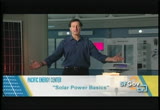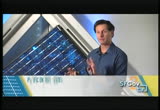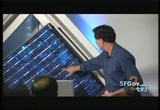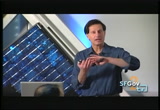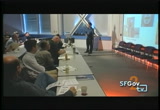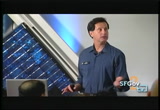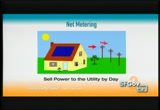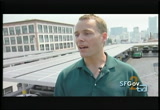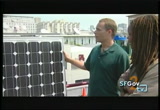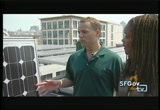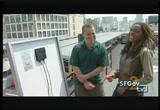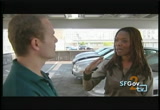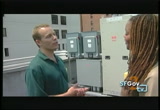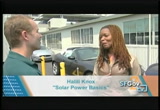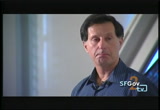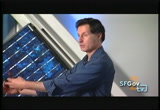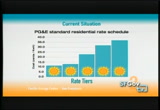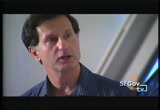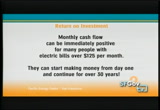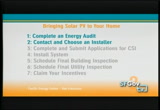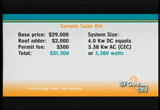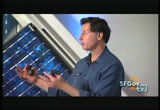tv [untitled] December 25, 2012 5:30pm-6:00pm PST
5:30 pm
really based on core engagement and core structure and core development. we do a lot of exercise in developing that and think about lengthening of the spine and our muscles. if you're a runner, if you're into kayaking, martial arts, cycling pilates are for you. >> programs are variety year around at various locations and to learn more come to the richmond athletic cente >> hi, my name is pete shoemaker and well toll energy center. i'm standing in front of a model of a home. this is one of the tools we use here to assess solar energy. five years ago i was in a position similar to that of many of you.
5:31 pm
i was a homeowner thinking about solar electricity for my home. i had to answer a bunch of questions. one, does this stuff work? would it work on my home and most importantly, can i afford it? well, i did the research. i bought a system. now i get to share that knowledge and that experience with you. for the next 30 minutes, we'll have a class in solar basics and we'll go out in the field and see an actual solar system being installed. 30 minutes, solar basics, stay with me. >> let's talk about the technology, what is it and how does it work? there are three types of solar actually when you sauk about solar. i want to avoid the confusion to make sure we're focusing on the right one. two of them involve heating water and they're very viable technologies, can be very coast effective but we're not going to deal with them right now.
5:32 pm
one is solar pool heating. it pumps the water up there, heats it, runs it through there, the sun heats it and back into the pool. this one is called solar thermal or solar hot water. it heats domestic hot water or d.h.w. that's your hot water that you use four showers and dishwashers. we're going to talk about solar electric. they have the same technology as computer chips. they're similar in structure to that tran cystor-like computer chip technology based on silicon. the best thing about them is there are no moving parts and they last a long time. there are cells, modules, and arrays. a cell is one of these pieces here. it's a small unit wired together in a certain way to produce half a volt. these are hooked together in whatever size to be a module or a panel. those terms are sort of used interchanningbly. you hook as many as you need to
5:33 pm
for your array. it is very modular and adaptable technology. you can put it whatever size you want. there are two sort of competing or comparable technologies on the market. crystal lynn is the one that's been the longest. it's made from crystals. it is firm, hard like crystal. they're over 85% or 90% of the market now. they have the highest efficiencies. in other words, they'll capture more of the sunlight per square foot than the other technology. this can be significant especially in a city like san francisco when maybe you don't have a lot of roof space, but you want to get as much power as you can. this is probably the choice preferred for most homeowners. the second technology which is coming on strong is called thin film. that's really a whole different technology using a lot less material. it's like sprayed or painted on, a different way of producing electricity. this stuff has a lot of potential because it can be used in a lot of different ways. this is a thin film panel here, right here and one of the innovative ways you can use
5:34 pm
this thing is on thought metal seamed roofs. they have an add he'sive backing on and they can stick down on the roof without penetrating the roof. it's a very effective and cheap and safe installation process. thin film has a smaller, a lesser efficiency. half as efficient but it's about half the cost. so if you look at it, a small system 1.2 kilowatt systems, it produces 1.2 kill what's in full sun or 1,200 watts. in crystal lynn it could would take 500 panels. in thin film it would take this much space. they would produce the same and at current prices they cost close to the same. let's look at the typical system components here and i'll show you how they're laid out on the house in a minute. we know what the array is. they're hooked together. they're mounted to the roof by rails and mounts. they're hooked together with wires and switches and things like that we call that the
5:35 pm
balance of the system. it's a relatively minor component as far as price goes. so your array is mounted to the roof. it's wired to the inverter which is a simple device that changes d.c. current to a.c. current. that's all it does. it fits on the side of the house next to the meter typically and isn't very large. about this big, a foot square maybe. so that's they typically are warranted for 10 years. they're probably last 15 years. so on a cost analysis for the system typically run an inverter replacement at year 15. the inverter is wired to your loads. it uses electricity, appliances, whatever and it's also tied to your meter. the only real visual impact on the house is the panels. the other stuff is almost never seen. the thing about solar panels is they work during the day owl. so the big question is what
5:36 pm
about at night? well when isn't shining. in the past the only solution you had to that was batteries. you would have to purchase a large group of batteries and wire them to your system. during the day the sun would produce what your house needed and charge up the batteries and at nighttime you would draw off the batteries. what has made solar go from a niche market and explode to a big popular market has been a breakthrough called net metering. because the sunshines differently during different parts of the year it makes sense to go for a whole year before you settle accounts. so you get a statement every month, but you don't have to pay it unless you want to. your credits or debits roll over from month to month and at the end of the year you settle accounts. the key concept is magical in a sense. the utility grid is a two-way street. you can send electricity back up in the lines. because you can do this, in effect, the grid can take the place of your battery. it reduces all of the cost of
5:37 pm
maintenance of electricity and ensures electricity. if you're tied to the grid, the grid is always standing there ready to serve you during the day it's charging a lot of power. my kids are at school, my wife and i are at work. there is not much going on. it's feeding my refrigerator or whatever. so most of my power is excess and being sent back into the grid. my meter is spinning backwards and banking credits to my account. when i come home at night, then i'm buying back electricity from the utility, drawing off my "virtual battery" in a sense. think of it as an economic transaction. you sell back during the day and buy at night. and that's how it works. hi, i'm here with carl, he is the operations manager for solar city. we decided to take a little break from the cls room to so we could see some of the solar
5:38 pm
panels in action. carl, how are you? >> very well. nice to meet you. >> how do you like the weather? >> not too bad. >> kind of sunny. how does that impact our solar panels when we have lots of sun versus fog which we are typically accustomed to in san francisco? >> well, contrary to popular belief, solar panels will produce electricity when it's foggy out. how much depends on the density of the fog. on a day like today it's hazy for typical san francisco weather. on a day like talking, you can expect 80% of your what would be your full production on a clear sunny day. >> so if i were thinking about getting solar panels and i lived in san francisco and i was worried about haze versus full sun and how that will impact what jets yated, are there any tools or tricks that i can use to determine what the production is going to be like? >> the first thing you need to do is look at what available area do you have. typically most residential systems gone on rooftops.
5:39 pm
in urban areas like this, we don't have big yards. they will go on rooftops. you need to have good southern access to sun. things that can impact your solar access are buildings in your vicinity, big trees, things that will keep the sun from reaching the available area on your house. >> how can i test myself before i get experts out to determine whether solar panels are going to work for me? i know, for example, one of my neighbors has an additional story. so sometimes that, you know, it's a little shady over there for a variety of reasons, but are there things that i can do in advance of having the experts out? >> sure. if you have access to your roof, you can go up there with a compass and face south and kind of look to the east and the west and see what's going to -- what's going to cast shadows. if there say large obstruction like a neighbor's house or a large tree directly to the south, it gets a little more complicated trying to measure
5:40 pm
exactly what impact that will have on the area you're considering. you have to consider where your neighbor's house is relative to due south if it's not northeast or the northwest, then it's not really a big deal. if it's due south and it's significantly higher than the area you're considering, you're probably going to get pretty good shading throughout the year there is actually published data about expected sun hours in the different neighbors in san francisco, and actually for the whole state of california. there is also some tools that you can use that will directly measure the sunlight at any given time, i actually have one with me ride now. >> show me. >> this is a meter and on a clear sunny day, you can expect about 1,000 watts per meter squared. >> is that enough numbers for my alarm clock or is that enough numbers for my refrigerator, what exactly is the ratio of energy to my appliances? >> it depends on your usage. if a large commercial building like this, they have a lot of
5:41 pm
electricity usage and they need a lot of panels here. your house will use a lot less. how much less depends on your usage. >> what is the impact of tilt versus flat and are those things that i need to think about before investing in solar panels? >> absolutely. you're tilting them up to harvest more sun and have them perpendicular to the sun. as utility them up, you can't have them close together anymore. as you can see my hands are shading each other here. you have to start separating them so they don't wind up casting shadows on each other. if you're able to get less panels in a given area. >> i would love to take a look at one of these solar panels if you have something that we can look at. are they heavy? what's the deal with this? >> you're 150, 100 something pound person walking on your roof. >> 150? >> i'm 150 pounds. >> carl! >> most modern houses are designed to take the weight of a solar panel instaglation. >> i don't have to worry about panels falling in on me?
5:42 pm
>> hopefully not. >> hopefully not. >> if you have a good contractor, they'll do their due diligence. they'll do their homework. it's better for the industry if everyone does their homework and does the calculations to make sure the system is going to last 20 years, 30 years. >> that is another question. what is the lifetime of the system? do you have to have the solar panels replaced periodically? >> no, actually the solar panels last a really long time. there are solar panels in operation from the 1950's and the 1960's. the inverter is a piece of hardware that has a lifespan between 10 years. they usually warranty between five and 10 years. that may need replacement down the line. the solar panels will last a good long time. this is what we have intalked here at british motors. what we have, there is no moving parts here as we are talking about. you have a tempered glass cover covering the cells themselves and an aluminum frame. each one of these little blue
5:43 pm
frames is the solar cell. the way this makes its power, you have the individual cells are tied together with these silver lines here which is actually thed soer which the equivalent of wiring. it ties the cells to each other in series or in parallel which are basic terms of saying how they join together, how they're wired together. this one here is about 35 pounds. you're welcome to check it out if you want. it's glass in an aluminum frame. >> let me see. >> you can do it, nice and light. >> oh, yeah. >> not too bad. not too bad. >> all right. >> and a typical residential install is in this area about five or eight kyl watts which is 5 or 8,000 watts. >> that would use 15 to 20 of these. >> how are the modules themselves connected to each other? >> on the other side of this, this wiring here that ties the cells together all goes to a
5:44 pm
single point. >> can we take a look at that? >> sure. if we turn the module around, up in here, this is called a junction box. and this junction box is completely sealed and water tight and feeds a couple of leads, these are already wired and they have quick connectors so you can just plug the modules into one another. >> how many of these does british motor cars as part of their install? >> cut. we actually have about 1,500 panels here between the two buildings of british motors. cut. [laughter] >> wow. so, carl, i get that all of the modules get connected through these -- >> connectors. >> connectors. but once they're all connected what happens? i mean, where does it go? >> ok. it's great that we're out here at british motors because we can actually show you that. the fact that we have a carport
5:45 pm
and it's elevated, we can see the underside and see what the underside of the installation looks like. this is a huge consideration, you want it to look good especially on something this exposed. >> where are the junction boxes? >> if you come out to the outside here, you can see the junction boxes on the individual modules and the wiring coming out of them. you can see here that these two panels next to each other are connected to each other. that happens throughout the array here. the modules get connected to each other. once that happens, that creates the d.c. voltage that we want to send out to the inverter which turns it into a.c.. >> now i'm understanding, carl, based on what you talked about earlier. the fact that these modules are all connected means if their shadow cast on one module, there really is an impact across all of the modules. is that accurate? >> there is an impact anytime you have shading, it does affect the performance of the system. there is technology in place
5:46 pm
that recently that minimizes the effects of the shading. it's not like christmas tree lights where if you take out one bulb, the rest of it shuts down. there is protection in the modules themselves that allow the electricity to pass through it when it's shaded and the inverter is also getting some smart technology in them to be able to handle variances in the mod use due to shading. >> so it sounds like we need to take a look at this inverter, is that possible? >> sure, it's on the other side of the building on the roof. let's take a walk over there. >> let's do it. >> after you. >> so this is it. this is where the magic happens? >> yep, this is the inverter here for the british motors installation. a residential inverter might weigh 50 pounds and be about 12 inches by 20 inches. they'll usually hang on your wall. they can be outside your house. they are weather tight. they can be inside your house in the garage or someplace else that's accessible. >> what would the next step in the process be if i were
5:47 pm
interested in solar panels? >> well, i think a great first step would be to find a reputable solar consultant, a solar installation company and talk to them about your needs and your desires. they should be able to look at your historical energy usage over time. they'll look at your past electricity bills. they'll come out and look at your house and work with you and also discuss your budget with you and come to a reasonable conclusion on what you can afford. how much power you need to generate, how long the payback is going to be on your system, what financing options are available and hopefully get you a soler power system designed and installed. >> well, i think i am going to need to graduate from pete's class first. i'll see about the next step. >> sure. >> thank you so much for all of these very useful information. >> my pleasure. >> really. >> yes. [laughter]
5:48 pm
>> i say it's going to cost you $30,000 for a solar system or $20,000. most people get sticker shock and run away. they forget what they're paying now. let's think of what you're paying compared to what? so, what you have now is typically a bill from p.g. and e., a gas portion and an electric portion cleared marked. look at the electric portion. you'll get a usage area and a box at the end. it will break down like this. it says five rate tiers you call them. you get a baseline rate at a cheap amount. you get another 30% amount at a cheap rate. this is your baseline rates, these two. but when you use more, you pay more. and what it looks like graphically is, boy, there is a lot up here. so these rates are where your big expenses come. if you're in these rates, solar can make a lot of sense.
5:49 pm
they go up very dramatically, 222 cents, 32. let's say we have a case study. you have a $100 electric only. that's $1,200 a year. after 10 years, it's $12,000 if rates don't rise. let's assume that rates rise at the historical average which has been 6% over the past 30 years. so let's assume -- i think that might be conservative, let's assume that. so that means that after 10 years, you'll probably have paid out $16,000 and your bill by then will be $169, $170 amonth. you would be out that much money and you would have a higher bill and look forward to, hopefully not, but probably increasing rent payments for ever and ever paying it off. can solar beat that? that's where you want to start. if it can't, don't buy it. if it can plus all of the other benefits, it's a great deal. there is ways to reduce the cost and eliminate the sticker shock and one of these ways is
5:50 pm
the california solar initiative, that wonderful law that we started at the beginning of the year. the incentives are of two kinds. if you win the lottery, you can either take an upfront payment or you can take an ongoing payment for x number of years. the same thing applies here. you can take what's called an epbb which is one of the world's great ack named called expected performance-based buydown which is a mouthful for rebate. the payment is by watt of capacity. so that's what you're going to get right up front to knock down the cost. if it was $25,000 or $30,000, that's a lot, but you get something knocked off. a lot of time the installers, the people that you deal with, the one stop shop that does the whole thing for you will carry the rebate for you. not all, but most of them do. so you don't even have to finance that and wait a few months to get it back from the state. they incur that floating finance charge for you. it's a real nice service and it
5:51 pm
lowers the cost right up front. so there is another incentive, two ways of lowering the cost. one is that rebate payment that i talked about with the state. this is from the federal government, ok. this is tax incentives. you have to have tax liability. you have to pay taxes to make this thing valuable to you, but most people do. the law is written at 30% of the cost you can have a tax credit of 30%. let's talk about real numbers. what am i paying now and what am i going to be paying in the future? if i can make money today on my monthly payment and go green, why not? solar kind of reverses the effect. it's like tax brackets. the return on investment typically is higher if you got a big bill. there is also another thing about time of use rates. i want to go over it very briefly. it does have some effect and you will hear it about on your bid. the time of use rate is a way
5:52 pm
that you tilts are trying to help -- utilities are trying to manage their peak demand. you charge people more during peak periods. you make it up to them by charging the low market rate off peak. this is off peak and you'll be charged a very low rate for it. at shoulder peak you'll be charged more. at on peak, you'll be charged the most, another shoulder, another off peak. so what happens is that your production looks like this on the hours of the day. you're going to produce more obviously during the suspect with peaking around noon. when you overlay the curve, they kind of look like this. so solar lines up very well with peak usage. remember when you're overproducing and selling during the day and buying at night, you can use this differential so you're selling high and buying low. that differential can actually use to your advantage depending on your lifestyle. ok, your paybacks ranges from eight to 18 years if you have
5:53 pm
to look at it that way from people who typically buy. the return anywhere from 5 to 15% or 18% or more on those big systems. so it's not a bad return for a very, very low risk investment. let's say you have 7% on p.v., you're going green. if you got that from your stocks, your principal would be going into risk. so anyway, stocks can go down as we well know. this is very solid. monthly cash flow, let's talk about that. if you were to finance this by a home secured loan like i did on my home equity line of credit, that interest on that loan is tax deductible. if you do that and assuming that we have the same historical rate of escalation, you can start going cash flow positive from the first day. in other words your payback can be immediate, now. making money. are there any hidden costs? the inverter typically is has a 10-year warranty that will last
5:54 pm
about 15 years we're estimating and they're getting better all the time. the solar people will build that replacement cost into your financial analysis and maintenance. the only maintenance that i ever do on my panels is a keep them clean when the pollen starts going. i don't live in a dusty area and i don't have birds nesting above the panels. i discourage that for obvious reasons. if they're tilted, you're going to be fine. on a real test, the maximum loss is around 7% even if they didn't wash them. most of the solar homes bought in the last five years and they're just starting to turn over. we're getting hard data on what this does to appraisal values. there has been some study that supports sort of the idea that, yeah, if two homes, all things being equal and the p.v. system looks decent, that if a home has $150 electric bill and this
5:55 pm
has a $10 a month, that going to be more valuable and have $140 available for mortgage payments, so you can pay more. we'll see if the figures will hold up. we need hard data to support that. it's very likely. there is also another thing about home ownership, california passed a solar rights act which is basically a law that basically supports solar, but it's very supportive law for h.o.a.'s and homeowners association and other condo things that can't privilege allowsly oppose solar. it's hard to oppose on a don't like the look of it, obviously you want to get along with the neighbors, but the law is on your side. now you're thinking maybe i want to continue to do this. first off do the energy audit stuff and find an installer like you would do any other contractor. he takes care of the paperwork and the permits for you and floats the rebate. you just got to get one you like and want and sign those
5:56 pm
papers. how do you find an installer and how do you choose the ones you want? just like anyone else, you screen some people out, you do personal references, you check their website, you talk to them about the basics and ask for the address to see if you have some good roof space. if you decide it's ok for a salesperson to come out, they'll do that for you. it's all free. if someone tries to charge you for bids, almost no one will. pass on it. i want to give you the key information that you need to compare bids properly. there is just one little area in there. there is a d.c. and an a.c. system size. i don't want to into details on that i want to make sure you get the right -- that's the only area of confusion that i have seen on bids that can affect the sales part of it. so first off, i want you to get the full price. that means the maximum you'll be charged. that includes any additional things that they may charge you because you have a difficult roof or steeply pitched roof or concrete tile or whatever they
5:57 pm
might see. you get that full price. that's before rebate, before tax credit. then you take the system size in cec, california energy commission a.c. watts. that term is understood by the people in the industry. that means they use the c.e.c. ratings to determine the a.c. wattage. you get the per watt price. you divide this by this. you get the price per a.c. watt. you want to ask about permit fees as well. each city typically will charge fees. now those fees are coming down and we're working very hard to get them standardized and clear. there is some cost. sometimes the installers will pass that on to you. ask how they're dealing with it. you say, ok, what's my watt. let's see it was four d.c. but you'll have 18% less here, so that's the number you want, you divide this by that and you get that. so this would be 926 a watt. therefore, you can compare
5:58 pm
apples to apples. they have a standard calculator that they use on the web and they include that printout on your bid and they have to file that printout in your rebate application. so there is another possibility of lowering costs, the group buy. when i went, in i went in with a bunch of friends because i thought i wanted to bring people in because i knew all of these people, these greeny homeowners that were needing to walk the talk and because i brought a lot of businesses vendor, they lowered all of our price because this economy is of scale. maybe that price can drop 50 cents a watt or more. that's another idea. there are ones that are just beginning where you can actually lease the system. you don't have to put any money up front at all. somebody else will own the system for you. you may pay an upfront cost a little bit that is less than what you might pay normally or some of them may not at all, depending on how they can make the finances work. the whole goal is to try to get
5:59 pm
you into p.v. with the least amount of resistance possible. instead of paying maybe the utility per month, you're going green and paying somebody else. thank you very much for your time. it's a pleasure. i'll take questions and i'll be here afterwards as long as you need me. thank you very much. [applause] >> so that's it, solar basics. first we talked about the technology, how it works and how it all hooks together. then we talked about net metering and how that makes solar easy and worry-free and finally we talked about the incentives from the state and the federal government that lower the cost and makes solar affordable. for further information visit our website or come visit us in person. all the classes at the pacific energy center are free of charge. thanks for showing us an
109 Views
IN COLLECTIONS
SFGTV2: San Francisco Government Television Television Archive
Television Archive  Television Archive News Search Service
Television Archive News Search Service 
Uploaded by TV Archive on

 Live Music Archive
Live Music Archive Librivox Free Audio
Librivox Free Audio Metropolitan Museum
Metropolitan Museum Cleveland Museum of Art
Cleveland Museum of Art Internet Arcade
Internet Arcade Console Living Room
Console Living Room Books to Borrow
Books to Borrow Open Library
Open Library TV News
TV News Understanding 9/11
Understanding 9/11
